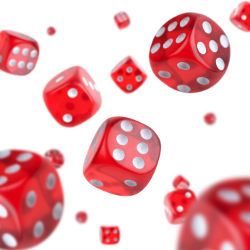
These puzzles involve computing probabilities associated with dice. A die is a cube with faces marked with numbers 1 to 6, as in the figure here, and we assume that when a die is rolled, each number is equally likely to come out on top. The questions we ask are somewhat unusual, though. We have collected several facts that run counter to many people’s intuitions. Our job is therefore both mathematical and psychological—first, make the calculation, then, if the answer strains our intuition, try to reconcile the conflict through reasoning.
- Six dice are rolled simultaneously, and the number N of different numbers that appear is determined; for example, if the dice show 3,4,1,6,5,6, then N = 5, and if they show 6,2,2,3,6,2, then N = 3. Clearly, N could be any number from one to six, but these values are not equally likely. What is the probability that N = 4?
- Alice and Bob roll a single die repeatedly. Alice is waiting until all six of the die’s faces appear at least once. Bob is waiting for some face (any face) to appear four times. The winner is the one who gets his or her wish first; for example, if the successive rolls are 2,5,4,5,3,6,6,5,1, then Alice wins, since all numbers have appeared, none more than three times. If the successive rolls instead happen to be 4,6,3,6,6,1,2,2,6, then Bob wins because he has seen four 6s and no 5 (yet). Now answer this easy question: What is the maximum number of rolls needed to determine a winner? And this more difficult question: Which player is more likely to win? This can be worked out with only a little bit of arithmetic, assuming you are clever enough.
- Alice and Bob have now secured a second die, roll the two dice together, noting the sum of the two values shown, and repeat. Each sum is, of course, a number from 2 to 12, with 7 the most likely outcome; six of the 36 ways to roll a pair of dice results in a sum of 7. This time, Alice is waiting for two 7s in a row, while Bob wants an 8 followed immediately by a 7. Which of them has the shorter average wait? And whose wish is more likely to come true first?
Readers are encouraged to submit prospective puzzles for future columns to puzzled@cacm.acm.org.




Join the Discussion (0)
Become a Member or Sign In to Post a Comment